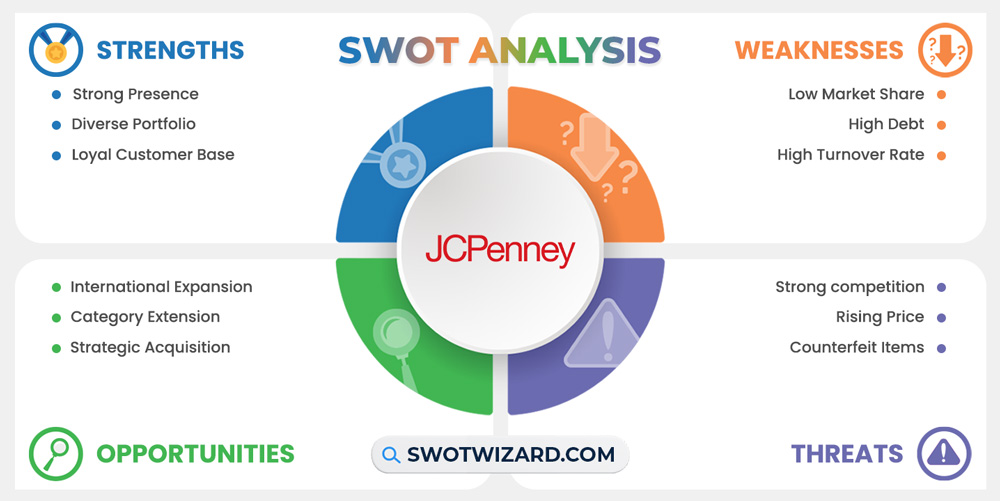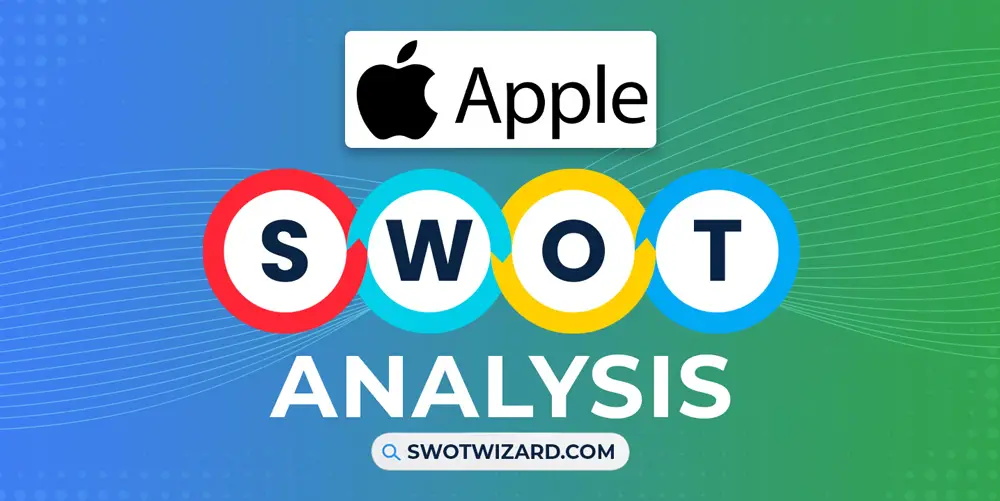JCPenney is an iconic American department store chain that has been serving communities across the nation for over a hundred years. If you’re a regular customer at JCPenney, it’s also possible that your father or grandfather might be a customer, too. Nostalgia aside, we will get to know more about the company and its business aspects in this JCPenney SWOT analysis.
JCPenney: Company Overview
| Company | JCPenney |
| Industry | Retail |
| Founded | 14 April, 1902 |
| Founder | James Cash Penney |
| CEO | Marc Rosen |
| Headquarter | Plano, Texas, U.S. |
| No. of Employees | 60,000+ |
| Annual Revenue | $11.167 billion (FY 2019) |
| Website | jcpenney.com |
Founded in Wyoming by James Cash Penney, the company started as a single dry goods store and grew over the next century to operate over 600 department store locations nationwide. JCPenney was a fixture in suburban malls and built a strong reputation as an affordable destination for apparel, home goods, and other family needs.
Over the last 120 years, it grew and became one of the renowned companies nationwide, employing over 36000 people.
Product & Services of JCPenney
Clothing | Footwear | Jewelry | Beauty products | Electronics | Furniture | Decor | Bedding | Bath | House wares | Appliances | Toys
JCPenney Competitors
Kohl’s | Walmart | Target | Macy’s | Nordstrom | Lowe’s | Home Depot
Did You Know?
In the early 20th century, JCPenney was one of the pioneers in catalog sales, allowing customers from rural areas to access a wide range of products through mail-order catalogs.
Strengths – JCPenney SWOT Analysis

Strong Presence: As one of the oldest department store chains in the US, JCPenney benefits from strong brand recognition and trust across the country. With around 664 stores nationwide, JCPenney has a far-reaching retail footprint that allows it to serve customers across 49 states in the USA and Puerto Rico. As a result, over 70% of consumers are familiar with the brand, which gives it an advantage over newer competitors.
Diverse Portfolio: JCPenney stores offer a diverse product portfolio across apparel, footwear, home goods, beauty, and more. From national brands like Nike and Sephora to owned brands like St. John’s Bay, the store aims to be a one-stop shop. In 2022-2023, the company offered merchandise from over 550 brands, catering to a wide swath of American families.
Loyal Customer Base: The company has a dedicated base of loyal customers, especially among older demographics who have shopped at JCPenney for decades. As a result, if we look at the data, approximately 65% of sales come from these loyal customers. Besides, skilled personnel, including retail professionals, designers, and merchandisers, have helped maintain the loyal base over the years.
Weaknesses – JCPenney SWOT Analysis

Low Market Share: JCPenney has posted declining comparable store sales in 8 of the last 10 years. According to data, its market share in the USA department store segment stood at just 2.1%, significantly lower than competitors like Macy’s (17.18%) and Kohl’s (6.3%) in 2022. Not to mention, the company is losing ground to competitors and online sellers.
Huge Debt: The company’s financial struggles have led to a substantial debt burden, with a long-term debt of over $4B as of January 2023. Because of that, it constrains reinvestment and poses risks to cash flow, limits investment in growth initiatives, and increases interest expenses, making it challenging to achieve profitability.
High Turnover Rate: The company has struggled with a consistently high employee turnover rate. In 2022, JCPenney reported an annual turnover rate of approximately 82%, which is notably higher than the industry average. As you can imagine, all these are leading to increased recruitment and training costs, lower employee morale, and potential service quality issues, impacting the overall customer experience.
Opportunities – JCPenney SWOT Analysis

International Expansion: The company can leverage its strong brand recognition to explore overseas markets.it’s always a good idea to tap into emerging markets like India or China, where the middle-class consumer base is expanding rapidly. The company can also tap into nostalgia and celebrate its rich history in marketing campaigns.
Category Extension: The brand can diversify its product categories to include niche segments. Expanding into athleisure wear to cater to the growing demand for comfortable yet stylish clothing brings many opportunities. Besides, it has an opportunity to spotlight its private labels like St. John’s Bay, which offer higher margins.
Strategic Acquisition: Acquiring or partnering with a tech-savvy e-commerce platform to enhance its online presence and customer experience is a matter of time now. By modernizing its e-commerce platform, delivery options, and in-store digital tools, JCPenney can meet customers’ omnichannel expectations.
Threats – JCPenney SWOT Analysis

Strong competition: JCPenney faces surging competition from discount chains like TJX and Ross Stores, big box retailers like Target and Walmart, and e-commerce giants like Amazon. In every aspect, the competitors are doing better in numbers, grabbing market share and pushing the company out of the market slowly.
Rising Price: In an era of cost-conscious consumers, increasing prices can deter shoppers. According to the Bureau of Labor Statistics, they reported an overall consumer price index increase of 5.4% in 2022, adding pressure to JCPenney’s pricing strategy. Besides, other external issues are also pressurizing the price directly and indirectly.
Counterfeit Items: The proliferation of counterfeit goods in the retail industry is a growing concern. According to the Organization for Economic Co-operation and Development, counterfeit products accounted for 5% of global trade in 2022, impacting brand reputation and consumer trust. As a result, there is always a concern for the company as it’s a renowned shop.
[Bonus Infographic] SWOT Analysis of JCPenney

Recommendations for JCPenney
The company has been facing issues from every side, and it’s getting difficult for them to bring it back to a stable market position. Here are some recommendations for them.
- Spotlight and expand private label brands to reinforce value positioning and differentiate from competitors.
- Strengthen loyalty programs and marketing campaigns leveraging nostalgia and emotional connections to celebrate JCPenney’s 120-year history and American heritage.
- Pursue strategic partnerships with popular athletic, apparel, and home brands to make JCPenney a destination for coveted merchandise and elevate brand perception.
- Expanding the market to other countries in the world and extending the product category would be a wise decision in the current scenario.
Frequently Asked Questions (FAQs)
How much money did JCPenney make?
JCPenney made $11.2B in 2022 in revenue.
Does JCPenney ship to Canada?
No, JCPenney doesn’t ship to Canada.
Final Words on JCPenney SWOT Analysis
While JCPenney faces immense challenges in today’s retail landscape, the company has opportunities to leverage its established brand equity, nationwide store presence, and product diversity if it can swiftly strengthen omnichannel capabilities, highlight private brands, and form strategic partnerships. However, the clock is ticking for this American retailer to modernize its operations and brand perception to become relevant for the next generation.
References
- Wikipedia contributors. (n.d.). JCPenney. Wikipedia.





